| Pages:
1
2
3
4 |
Rainwater
National Hazard
   
Posts: 799
Registered: 22-12-2021
Member Is Offline
Mood: indisposition to activity
|
|
Lol. Sorry couldn't resist. It reacted violently and produced a lot of HCl vapor, by the smell of it
Edit: did it again, 1g of ammonia chloride this time.
this reaction was very well-behaved (endothermic) I might scale this up to get enough to properly test.
I can use silver nitrate solution to test the chloride content.
HCl container next to a sample to test for ammonia.
Any other testing suggestions? Whats this used for anyway
[Edited on 14-12-2022 by Rainwater]
"You can't do that" - challenge accepted
|
|
|
clearly_not_atara
International Hazard
    
Posts: 2692
Registered: 3-11-2013
Member Is Offline
Mood: Big
|
|
AlCl3 is a Friedel-Crafts catalyst. Refluxing it in xylene or toluene will cause (slow) disproportionation to benzene and mesitylene. It has
significant covalent character and therefore dissolves in many organic solvents, while its hydrates do not. So dissolving it in e.g. chloroform may
serve as a test.
[Edited on 04-20-1969 by clearly_not_atara]
|
|
|
sceptic
Harmless

Posts: 49
Registered: 7-6-2022
Location: Southern Africa
Member Is Offline
|
|
Thanks for testing this, Rainwater, I'm glad to see you were successful!
When you say that you heated the mixture until it began to melt, do you mean that the ammonium chloride began to melt? I'm asking because I had the
impression that ammonium chloride didn't really melt, it decomposed into gaseous ammonia and hydrogen chloride. Was the aluminium that you started
with used up by the end of the reaction?
|
|
|
Rainwater
National Hazard
   
Posts: 799
Registered: 22-12-2021
Member Is Offline
Mood: indisposition to activity
|
|
Ya
So after drying the ammonia by heating it until it decomposes/sublimated. Let everything cool.
I added aluminum foil. What I believe to be a stoichiometric excess, and started heating.
I witnessed a red/orange liquid forming on the bottom of the tube. Likely to be a molton salt, or even molten aluminum. Or the red stain on my test
tube left from the silver testing.
Most of the aluminum was consumed in the reaction.
I have some new theories about what is happening and have been thinking of ways to disprove each.
R1)$$ 8NH_4Cl(s) + 2Al \rightarrow 2(NH_4)AlCl_4(s) + 6NH_3(g) + 3H_2(g)$$
R2)$$ 6NH_4Cl(s) + 2Al(s) \rightarrow 2AlCl_3(s) + 6NH_3(g) + 3H_2(g)$$
For reaction #R1, I have been able to find short incomplete references to this compound, no detailed information about its synthesis or properties.
For reaction #R2, i think it is possible do to ammonia gas being lighter than HCl gas. So when the ammonia chloride decomposes, the aluminum is left
sitting in a hot bath of HCl gas and the reaction proceeds like so
$$2Al + 6HCl \rightarrow 2AlCl_3 + 3H_2$$
My next experiment will answer these questions.
Q1) At what temperature does the reaction take place
Q2) does the reaction release any gas and if so what
Q3) what is the yield/weight of leftover reagents/products
Proposed appratus
My thinking is to start with a 100mL Rbf, clasien adapter with thermocouple and gas port, tubing and mineral oil bath, under an inverted cup flooded
with oil.
Proposed procedure
A1) By monitoring the temperature vs power input, I should be able to see that at some point the apparatus requires more heat/power to
maintain/increases the apparatus temperature. Being an endothermic reaction this will signal that the reaction has started and ended. This will
require another software rewrite to add more data collection so may not happen this time. But deffenetly sticking a thermocouple in there
A2) By using a bubbler, i hope to collect any gases that are generated by this reaction. Maybe even use the gas as a method to measure reaction rate
and endpoint
A3) by taking accurate weight measurements of all components of the appratus both before and after the reaction, then using the formulas R1 and R2.
One formula should predict the observed weights
Edit:
I always miss something obvious, any suggestions?
[Edited on 17-12-2022 by Rainwater]
"You can't do that" - challenge accepted
|
|
|
blogfast25
International Hazard
    
Posts: 10562
Registered: 3-2-2008
Location: Neverland
Member Is Offline
Mood: No Mood
|
|
I remain skeptical re. your proposed reaction equations: it's easy to out write 'pretty balanced equations', but much harder to prove their
veracity...
But I'll wait for your next results, before critiquing (or not?)
|
|
|
clearly_not_atara
International Hazard
    
Posts: 2692
Registered: 3-11-2013
Member Is Offline
Mood: Big
|
|
Ammonium tetrachloroaluminate is described as melting cleanly 303 C:
https://pubs.acs.org/doi/pdf/10.1021/ic50148a012
This seems basically consistent with the other observations. The ammine AlCl3*NH3 is also described, and it is suggested to form upon boiling at 402
C. I don't know if it is feasible to obtain AlCl3 from the ammine. It does work with ZnCl2*2NH3, which suggests that the NH4Cl + Zn reaction could be
worth investigating (beware of Zn vapor).
[Edited on 04-20-1969 by clearly_not_atara]
|
|
|
blogfast25
International Hazard
    
Posts: 10562
Registered: 3-2-2008
Location: Neverland
Member Is Offline
Mood: No Mood
|
|
I'm very skeptical that NH4AlCl4 can be prepared as described above. The alkali metal tetrachloroaluminates are prepared very
differently, as is ammonium tetrachloroaluminate, by your own reference (which starts from AlCl3!)
As regards the 'other observations', there really isn't all that much.
Also if it was possible to oxidise Al 0 to Al+3 we would have heard about it by now.
[Edited on 18-12-2022 by blogfast25]
|
|
|
unionised
International Hazard
    
Posts: 5102
Registered: 1-11-2003
Location: UK
Member Is Offline
Mood: No Mood
|
|
Quote: Originally posted by blogfast25  |
Al2S3 is one of the stinkiest things I've ever made, it's incredibly sensitive to moisture and water.
"And for that reason, I'm out!" |
In principle, I'm giving you a way to get rid of it.
:-)
Yes it's a PITA to work with, but the interesting plan it to create it and then react it, without ever needing to isolate it.
Maybe if I get bored some time...
|
|
|
blogfast25
International Hazard
    
Posts: 10562
Registered: 3-2-2008
Location: Neverland
Member Is Offline
Mood: No Mood
|
|
Please do!
|
|
|
Rainwater
National Hazard
   
Posts: 799
Registered: 22-12-2021
Member Is Offline
Mood: indisposition to activity
|
|
Quick question, what liquid boils around -33.6c and turns blue when sodium metal is added 
https://youtu.be/im3LMio-dyE
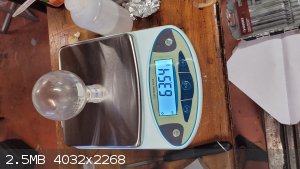 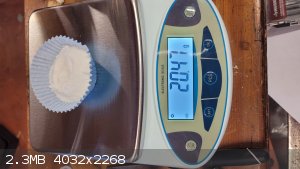
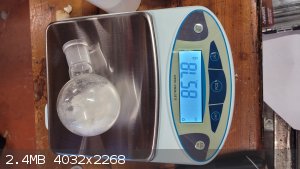 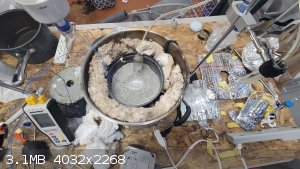
If i get to name something im calling it "ashley's oxidation"
Lab notes
| Code: | 2022-12-18
Test tube placed in sand bath, 900watt heater controled by a triac in insulated pot.
Duckseal will be used to secure gas collection tube in reaction vessel.
Tub leads to a test tube(15ml) in a dry ice acetone bath.
Thermocouple is tapped to bottom of the reaction vessel.
Reaction vessel weights 23.35g
0.48g of aluminum foil was weighed.
When added to the reaction vessel the total weight is 24.01g
That is a difference of 0.66g
I will trust the weight of the aluminum packed into the test tube vs the weight of the foil in air.
Math section
NH4Cl mol weight 53.49g
Al mol weight 26.982g
NH3 mol weight 17.031g
Ammonia density 0.6819 g/cm3 at −33.3 °C
Predicted products are H2 gas and NH3 gas
0.0244607516mol of aluminum are in the reaction vessel
Gas collection test tube is 15ml
By reaction R1 8mol of NH4Cl = 6mol NH3
By reaction R2 6mol of NH4Cl = 6mol NH3
5ml of liquid ammonia seems like a safe limit.
By reaction R2, which will produce the most NH3 per mol of HN4Cl,
5ml * .6819g/ml ÷ 53.49g/mol NH3 = 0.0637408861 mol of NH3 to collect, which requires 6mols or 20.47g of NH4C and 1.71g of al.
So aluminum was added until 1.71g was the weight
And i dont know if i can fot that much salt into the test tube
Switching to rbf 100ml weight 63.54g
Rbf w/ al 65.29g = 1.75g difference
1630 heat applied. 20% power
Sand bath 16c
Cold trap -67.8c
1640 no observation
Sand bath 112.5c
Cold trap -67.2c
Heating played with.
Full power 30seconds then minimum power, repeat when temp quits rising
1646 sand bath 155.0c no observations
1648 sand bath 165.0c no observations
1650 sand bath 178.0c no observations
1656 sand bath 193.8c no observations
1700 sand bath 202.5c no observations
1704 sand bath 226.8c no observations
1710 sand bath 271.5c no observations
1712 sand bath 282.0c no observations
1714 sand bath 292.3c no observations
1716 sand bath 309.4c no observations
1718 sand bath 321.5c no observations
1720 sand bath 330.1c no observations
Heating adjusted to maintain slow temp increase
1725 sand bath 332.1c power ~50%
1726 sand bath 335.6c
reaction vessel appears to have white dust on the inside where their was none before
1730 sand bath temp 334.6c amd falling, nonadjustment to power has been made since 1725
1734 sand bath 332.3c heating power increased
1738 sand bath 352.7c reaction vessel has much more dust on the inside
1742 sand bath 358.8c heating power increased
1746 sand bath 389.5c
1753 sand bath 414.0c heating stopped.
Chear Liquid has condenced in my test tube.
Verified by smell, ventilation was inadequate, need bigger fans
Added sodium metal. Condensate turned blue.
Appratus cooled and capped gently
|
Edit:
As it has been kindly pointed out to me, this proves nothing but
1) you can make silver metal explosively from AgCl + Al
2) you can collect HCl Solution from the solid product of (NH4Cl + Al) plus H2O
3) you can create NH3 from NH4Cl + Al
4) 2 wide open garage doors and 2 box fans are not enough to deal with liquid ammonia
[Edited on 19-12-2022 by Rainwater]
Looks like im not the first to propose this reaction but can find nothing on it being tested
https://www.sciencemadness.org/whisper/viewthread.php?tid=53...
[Edited on 19-12-2022 by Rainwater]
[Edited on 19-12-2022 by Rainwater]
| Code: |
2022-12-19
After reviewing videos, liquid ammonia was at first clear, but befor adding sodium, volume collected had doubled ( around 1ml total) and had a yellow tent.
Reaction vessel was checked for damage, none found.
A white powder condenced in the tubing leading to the cold trap
Lots of white solids where scraped off the reaction vessel walls.
Nothing was removed from reaction vessel.
When setting up the water trap, some of the solids fell from the tubing into the universal indicator solution changing it from a light green(ph 6.9~7)
To a yellow green(ph 6.4~6.7)
Appratus was reconfigured to add a stright column to the reaction vessel to catch sublimated compounds
A water trap with bromothymol blue solution was connected to the gas outlet in such a manner that suck-back can not occurr
0905 heating started 25% power
|
[Edited on 19-12-2022 by Rainwater]
"You can't do that" - challenge accepted
|
|
|
blogfast25
International Hazard
    
Posts: 10562
Registered: 3-2-2008
Location: Neverland
Member Is Offline
Mood: No Mood
|
|
Quote: Originally posted by Rainwater  | Quick question, what liquid boils around -33.6c and turns blue when sodium metal is added 
https://youtu.be/im3LMio-dyE
Edit:
As it has been kindly pointed out to me, this proves nothing but
1) you can make silver metal explosively from AgCl + Al
2) you can collect HCl Solution from the solid product of (NH4Cl + Al) plus H2O
3) you can create NH3 from NH4Cl + Al
4) 2 wide open garage doors and 2 box fans are not enough to deal with liquid ammonia
|
So did you measure the temperature of your presumed NH3?
That video is pure crap and doesn't seem to show anything relevant anyway.
Right now it looks strongly like your R1/R2 is indeed proceeding.
|
|
|
Rainwater
National Hazard
   
Posts: 799
Registered: 22-12-2021
Member Is Offline
Mood: indisposition to activity
|
|
Ya i had a ktype thermocouple submerged in the ammonia.
It started at -67c and warmed up until it was boiling off at -33.6c
close enough for me, that's within the error of my equipment and tolerance of my nose
I agree the video is crap,i was freaking out that this worked
And i mean i was $<"(>,% thrilled. Hands shaking, knees wobbly,
I may have wet myself a little bit.
If anyone wants better video then please petition a youtuber, nerdrage is my favorite
Im a watcher not a maker.
Updated Pdf including this mornings experiments
https://www.dropbox.com/s/ahcf7pm7pd4wpsr/Alcl3%20test%20202...
Got a bunch of pictures in it 30meg file
Im trying to narrow down tempature the reaction takes place
Looks to be just north of 350c
Lab notes
| Code: |
2022-12-19
After reviewing videos, liquid ammonia was at first clear, but before adding sodium, the volume collected had doubled ( around 1ml total) and had a yellow tent.
The reaction vessel was checked for damage, but none was found.
A white powder condensed in the tubing leading to the cold trap
Lots of white solids were scraped off the reaction vessel walls.
Nothing was removed from the reaction vessel.
When setting up the water trap, some of the solids fell from the tubing into the universal indicator solution changing it from a light green(ph 6.9~7)
To a yellow green(ph 6.4~6.7)
Apparatus was reconfigured to add a straight column to the reaction vessel to catch sublimated compounds
A water trap with bromothymol blue solution was connected to the gas outlet in such a manner that suck-back can not occur from the larger gas trap colored with the same indicator
T1 = top of the column
T2 = bottom of the column
T3 = sand bath (top of sand)
T4 = sand bath (bottom of reaction vessel)
0905 heating started 25% power
T1 18.1c T2 18.0c T4 18.3c
0915 T1 18.1c T2 18.1c T4 44.5c
0925 T1 18.5c T2 19.0c T4 124.6c
the liquid is starting to rise in the gas trap bubbler. The water trap solution has lost all yellow color. Gas trap and water trap show ph of 6.9~7
0935 T1 18.4c T2 19.1c T4 182.2c
0940 T1 16.0c T2 15.7c T4 202.3c Doors were opened, outside temp -1c
0945 T1 14.5c T2 14.3c T4 214.8c
0952 T1 13.2c T2 15.3c T4 232.9c Doors shut heating power 40%
1002 T1 17.2c T2 20.4c T4 277.0c no observations
1007 heating power lowered to slow rate in increase
1027 T1 20.4c T2 26.3c T4 343.3.1c
1038 T1 20.6c T2 28.8c T3 232.7c T4 355.0c
T3 was added to the top of the sand bath
1040 T1 20.4c T2 27.6c T3 241.8c T4 359.1c
Color change in water trap, darker shade of green when compared to previous picture
New image on left, old on right
1050 T1 21.9c T2 33.8c T3 261.9c T4 371.4c
1055 T1 22.1c T2 34.6c T3 274.3c T4 379.5c gradient of 105.2c
1100 T1 22.0c T2 36.1c T3 282.4C T4 381.4c
time laps video started,
1104 T1 21.8c T2 42.3c T3 295.1c T4 387.8c
found sd card, video started
The strong smell of ammonia tell me my appratus is leaking
Bottom of column has began showing signs of sublimation
1113 T1 23.7c T2 40.1c T3 309.6c T4 390.2c
Bubbbles in water trap and gas trap with significant color change in water trap
1120 T1 23.1c T2 45.0c T3 326.5c T4 346.2c
heating lowered, bubbling was aggressive
1127 T1 21.6c T2 35.5c T3 333.3c T4 317.6c
Doors opened outside temp 0.5c
Heating increased, reaction has begain suck-back
1130 T1 20.0c T2 34.4c T3 336.9c T4 323.3c
bubbles started again, gas trap has started turning blue
Heating lowered smallest ammount possible
1140 T1 18.2c T2 42.9c T3 348.7c T4 320.0c
reaction completly stopped suck-back max
Heating increased
1143 T1 17.8c T2 69.8c T3 354.5c T4 324.2c
Reaction started again, suckback has decreased
Cracking was heard. Heating off
1147 T1 20.2c T2 77.5c T3 366.7c T4 327.2c
Powder made it to the water trap
Reacted violently upon contact generating lots of gas
Solution color went fron dark blue to light blue
Shortly after the powder did not have the same effect when toughing the water
1150 T1 19.5c T2 68.2c T3 378.1c T4 329.1c
heating turned back on
1205 T1 20.1c T2 48.8c T3 413.3 T4 349.9c no observations
1210 Experment stopped. Lunch
Appratus cooling.
|
So while i wait for everything to cool down i found limited solubility data regarding AlCl3 and no data for the ammonia complexs mentioned by others.
http://chemister.ru/Database/properties-en.php?dbid=1&id...
http://chemister.ru/Database/properties-en.php?dbid=1&id...
States that NH4Cl is "sparingly soluble" in acetone while
AlCl3 is 57.5 (18°C) per 100g of solvent.
Are there any known reactions between acetone and AlCl3 which would prohibit it being used as an extraction solvent at room temp?
Can anyone provide relevant data regarding the solubility of the other perdicted products?
[Edited on 19-12-2022 by Rainwater]
Glass wool fibers that where inserted into the column as a filter, where placed into a test tube containing 1 drop of the generated ammonia solution,
5ml of water and 1 drop of universal indicator. When the fibers contacted the solution, the ph went from 8.1~12.5 to 6.4.
[Edited on 19-12-2022 by Rainwater]
"You can't do that" - challenge accepted
|
|
|
blogfast25
International Hazard
    
Posts: 10562
Registered: 3-2-2008
Location: Neverland
Member Is Offline
Mood: No Mood
|
|
Quote: Originally posted by Rainwater  |
States that NH4Cl is "sparingly soluble" in acetone while
AlCl3 is 57.5 (18°C) per 100g of solvent.
Are there any known reactions between acetone and AlCl3 which would prohibit it being used as an extraction solvent at room temp? You would then
sublime the AlCl3 off, to separate it from the excess Al.
|
It doesn't look like it, no.
But having to carry out a post-reaction separation (work-up) would be a drawback of this method. Maybe it would be wise to try again with a strong
stoichiometric excess of Al with respect to the NH4Cl?
[Edited on 19-12-2022 by blogfast25]
[Edited on 19-12-2022 by blogfast25]
|
|
|
clearly_not_atara
International Hazard
    
Posts: 2692
Registered: 3-11-2013
Member Is Offline
Mood: Big
|
|
What did you mean by this? Aluminum oxidizes very readily as long as its oxide layer is somehow compromised (many methods have been described).
As for the rest, I would agree that there are many other possible products comprising various condensations of AlCl3 and NH3. But, certainly,
aluminium can be oxidised.
In fact even the reaction of aluminum with vapor-phase ammonium chloride has been reported (producing aluminum nitride):
https://www.sciencedirect.com/science/article/pii/S004060901...
and further AlN by microwaving Al+NH4Cl+urea:
https://link.springer.com/content/pdf/10.3103/S1061386210030...
Of course, AlN (mp > 1000 C) certainly can't be the liquid product. But all references I found on this reaction focus on the production of AlN.
[Edited on 04-20-1969 by clearly_not_atara]
|
|
|
blogfast25
International Hazard
    
Posts: 10562
Registered: 3-2-2008
Location: Neverland
Member Is Offline
Mood: No Mood
|
|
I meant in @Rainwater's context, of course: oxidation by NH4Cl to AlCl3. Sorry for not being clearer!
|
|
|
Rainwater
National Hazard
   
Posts: 799
Registered: 22-12-2021
Member Is Offline
Mood: indisposition to activity
|
|
I just want to say thanks to everyone who has responded to this thread.
Currently, I'm overly excited that we have been able to apply the scientific method and developed a theory, that has merit and is worthy of further
investigation and experimentation.
Joyful rant over:
In the context of an amateur chemist forming this compound,
with the intent to use it for a greater purpose,
I agree 100%
I think that the observations I have witnessed were occurring in the gas phase.
Which is incredibly dangerous and hard on equipment.
I let that flask cool for 4 hours. It is currently 175c and dropping nice and slow.
I fully expect the rbf and column to be unfit for further use after this mornings experiments.
All downsides to this procedure. But a proof of concept for further research
I'm hoping that using acetone or some other solvent, this reaction can take place at lower temperatures in solution.
Thermodynamics says 11c.
Kinetics says chemicals need to be able to touch each other.
In the gas phase, ammonia chloride produces HCl which strips the passiveation layer off the aluminum letting it be attacked and freeing ammonia. I'm
hoping something similar will happen in non aqueous solution.
I am also focusing efforts to easily obtained reagents.
"You can't do that" - challenge accepted
|
|
|
sceptic
Harmless

Posts: 49
Registered: 7-6-2022
Location: Southern Africa
Member Is Offline
|
|
Nice experiment!
Quote: Originally posted by Rainwater  |
Are there any known reactions between acetone and AlCl3 which would prohibit it being used as an extraction solvent at room temp?
Can anyone provide relevant data regarding the solubility of the other perdicted products?
|
I haven't been able to find any good references for a reaction, but there is this site which mentions that aluminium chloride forms complexes with ketones, which is what I would expect given how strong a Lewis acid it is.
According to this site it should be soluble in a variety of haloalkanes.
|
|
|
Rainwater
National Hazard
   
Posts: 799
Registered: 22-12-2021
Member Is Offline
Mood: indisposition to activity
|
|
So here's what I got so far
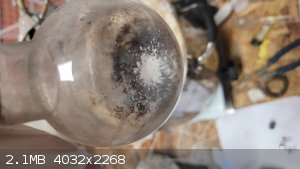 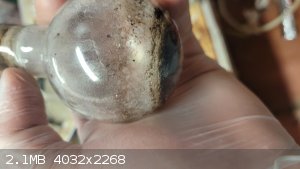 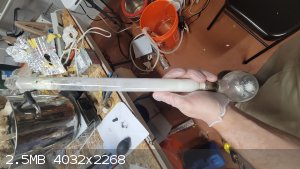
The reaction vessel (100ml RBF) has survived. And currently contains 8.02g of material.
The total reaction weight was 22.24g meaning 14.22g has moved
white solids recovered by scraping was weighed 3.37g and labled "crude"
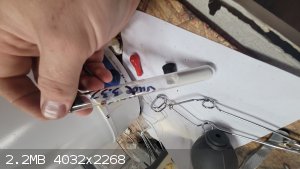
At least twice that was rock hard in the column and would not scrape off.
Column washed with room temp(16c 250ml) acetone and contents scraped off with a metal rod.
Currently removing acetone by distillation.
Acetone turned to milk upon contact with products.
Compounds will be processed separately.
Noticed that at first, all the easy-to-remove powder, was free-flowing and clump-free. After moments in the air it begain to get clumpy and lumpy.
Powder stored and capped as fast as possible.
Crude powder turns damp ph paper red upon contact.
Acetone solution turns damn ph paper red upon contact
Di water being used does not change ph paper color
Acetone being used does not change ph paper color
Next test will be sublimation tempature of both samples.
Edit:
Lab notes
| Code: |
2022-12-20
All appratus has cooled over night, capped off.
Column and rbf needed to have the joint tourched to free then.
Nothing appears damaged.
Glass fiber that was in column was used to clean column of powder and column scrapped throughly.
Powder extracted from appratus. 3.37g white/gray and placed in a test tube labled "crude"
RBF weight - 71.65g
Solid black mass, like concrete is stuck to the bottom
Column was coated in white concrete like powder. 250ml of 16c acetone effectively cleaned column.
Washing solvent was setup for distillation. Sandbath at 90c was used
Solids from rbf where scraped out. All but 0.14g where recovered.
Total recovery from rbf is 7.84g and placed in a test tube labled "rbf"
Material left in the funnel from rbf reacts with air changing to a green color, material in test tube is a mix of black rock and gray powder
Samples from di water where placed on ph paper, no color change
Sample from acetone source was placed on damp ph paper, no color change.
Sample from "crude" the size of a grain of table salt was placed on damp filter paper, color changed to dark red(ph 1~2)
Sample from acetone roughly 0.10ml was placed on damp filter paper, color changed to dark red(ph 1~2)
Sample from funnel( green compound) was placed on damp filter paper,
color changed to dark red(ph 1~2)
A black sample from "rbf" the size of a grain of table salt was placed on damp filter paper, color changed to a darker orange (ph 6).
After time it was observed the ph paper turned dark red(ph 1~2)
A gray sample from "rbf" the size of a grain of table salt was placed on damp filter paper, color changed to dark red(ph 1~2)
Waiting on distillation to complete.
Funnel is being left out on air to see what happens
Beaker used in acetone washing is coated in white power. This powder has not changed colors upon sitting in air. Powder has a pasty cream like texture and turns ph paper bright red before paper is damp.
Upon wetting paper, ph shows 3 |
[Edited on 20-12-2022 by Rainwater]
More notes and rambling numbers
| Code: | Distillation complete, Stir bar removed. Placed on ph paper and wetted.
The compound did not effect the ph paper
Material was white/pink and hot. Boiling flask shows color change
It should be notes that
A vinyl glove was damaged and entered into the acetone wash.
7.39g of powder was recovered from the acetone wash and placed into a test tube labled "acetone"
Total amount of recovered compounts 18.60g estimated 1g not recovered
From appratus and wash beaker.
No accurate information available for weight of gas products.
Experment summary
1.71g al metal = 0.06337 mol/ al
20.47g NH4Cl = 0.38025 mol/ NH4Cl
Total reagents 22.18g
6.476g of NH3 theoretical 100% yield
Completed reaction 18.60g
RBF 7.84g
White powder collected 3.37g
Acetone extracted 7.39g
83.86% mass retained
16.14% mass lost
Reaction was first ran until gas products were released then stopped
Next day reaction was ran untill no more gas products where released.
Then held above reaction temp (350c-400c) for at least 30 minutes.
Reaction vessel was slowly cooled to 100c over 6 hours.
Reagents sublimated from the reaction vessel to the condenser column and no longer reacted.
8NH4Cl(s)+2Al→2(NH4)AlCl4(s)+6NH3(g)+3H2(g)
481.89g → 102.186g NH3 or 21.205% ammonia by mass
6NH4Cl(s)+2Al(s)→2AlCl3(s)+6NH3(g)+3H2(g)
176.784g → 102.186g NH3 or 57.80% ammonia by mass
Acetone test tube placed in vacuum chamber
|
Pdf updated
https://www.dropbox.com/s/ovr1as4g39g468x/Alcl3%20test.pdf?d...
[Edited on 20-12-2022 by Rainwater]
"You can't do that" - challenge accepted
|
|
|
Rainwater
National Hazard
   
Posts: 799
Registered: 22-12-2021
Member Is Offline
Mood: indisposition to activity
|
|
Got something after holding 190c for 30 minutes.
Currently going to 230c.
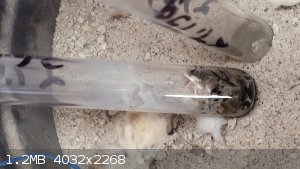 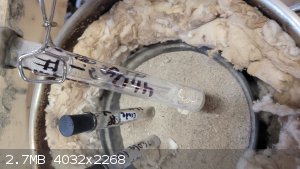
Edit: at 230c a liquid was observed in the test tube labeled "RBF"
It quickly solidifies when removed from heat
[Edited on 21-12-2022 by Rainwater]
"You can't do that" - challenge accepted
|
|
|
Σldritch
Hazard to Others
  
Posts: 309
Registered: 22-3-2016
Member Is Offline
Mood: No Mood
|
|
Why would anyone want 'AlCl3' so contaminated with Ammonium Chloride? Seems pretty useless.
If you want to moderate the reaction I would use Lead/Aluminium-alloy instead of Aluminium with PbCl2. With the lead melting and the
possibility of sublimation separation should be a breeze.
|
|
|
Rainwater
National Hazard
   
Posts: 799
Registered: 22-12-2021
Member Is Offline
Mood: indisposition to activity
|
|
I agree, but thats not my goal. It would be much easier to generate cl2 gas and burn aluminum, than to explore a previously undocumented chemical
reaction
Edit: sorry thats not ment to sound as blunt as its read
This method for producing a pure reagent
...sucks...
All I have been able to do is, show without a dought that the production of anhydrous AlCl3 from the experiments described above is maybe
possible.
All n all ive enjoyed myself. And learned a few things.
Best i can conclude from the data available to me is both reactions R1 and R2 are taking place.
From the product subliming out at 190c to the observed liquid at 230c. The ph of each sample shows results expected with these products. And the
violent reaction with water, hygroscopic property's.
If my lab technique was more developed and matured i belive i would have been able to obtain a pure sample of the product.
I made many mistakes that were easy to avoid.
Shuting down my reaction at the first sign of gas production was a big one, insufficient surface area to condense the products, another.
[Edited on 21-12-2022 by Rainwater]
"You can't do that" - challenge accepted
|
|
|
blogfast25
International Hazard
    
Posts: 10562
Registered: 3-2-2008
Location: Neverland
Member Is Offline
Mood: No Mood
|
|
So what is your goal then?
|
|
|
Rainwater
National Hazard
   
Posts: 799
Registered: 22-12-2021
Member Is Offline
Mood: indisposition to activity
|
|
To prove whether or not this reaction takes place. Once that's done, which I believe it is, then optimization of recovery of the product
Lab notes
https://www.dropbox.com/s/ovr1as4g39g468x/Alcl3%20test.pdf?d...
[Edited on 21-12-2022 by Rainwater]
Experiment ended with the addition of water to the 3 samples
Rbf was the most reactive. Boiling the water upon contact. Strong smell of hcl, addition of water had to be keep slow to prevent boil over. ph 2~3
Crude was second most reacting with the tube heating up amd a slight smell of hcl. ph 4
Acetone was the least reactive with the tube only warming up. ph 6
All 3 tubes now have a merky black solution with a red tent
[Edited on 22-12-2022 by Rainwater]
"You can't do that" - challenge accepted
|
|
|
sceptic
Harmless

Posts: 49
Registered: 7-6-2022
Location: Southern Africa
Member Is Offline
|
|
It would be quite difficult for me to make aluminium chloride from any reaction involving gasses as reactants, because I don't have the equipment.
With this, I should be able to make small amounts in a test tube. There are some purposes for which it doesn't have to be pure. I'm planning to use it
to make sodium tetrachloroaluminate.
|
|
|
Rainwater
National Hazard
   
Posts: 799
Registered: 22-12-2021
Member Is Offline
Mood: indisposition to activity
|
|
My new theory is that during the first attempt, AlCl3 was formed. Then during the second test. when i had the powder/smoke flood past and into the
water trap, i lost a large amount of product in the water trap
.
Additional losses occured with the mixture of AlCl3 and NH3 gas in the appratus
l've gots one more thing I want to try before I move on from ammonia chloride.
A mineral oil bath, at 189c.
it's a long shot but I think if it can evolve ammonia gas the oil will act as a barrier to protect the compounds formed. Ammonia is insoluble in
mineral oil, so is ammonia chloride. But if the smallest amount of NH3Cl will dissolve, the reaction should take place.
Even if it is impracticaly slow
As for the liquid salt observed. Very unexpected and literature is either non-existant or behind a paywall.
The only thing I have found that fits the observations is AlH3
I've got 3 samples im going seal in glass, willing to send them to someone if they would agree to perform a proper analysis and publish all results.
Moving on from there, i have some stannous chloride(dihydrate)
Not sure if it can be made anhydrous by heating above 250c
But if it can that is a much lower reaction temperature than 330c
The second problem is thermodynamics indicates it will be more exothermic than silver chloride.
Back to the test tube.
After that I will attempt zinc and lead, ive found documents showing the successful synthesis using these reagents, so thats a little boring.
Edit:
[Edited on 22-12-2022 by Rainwater]
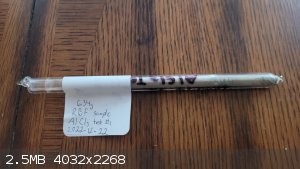
"You can't do that" - challenge accepted
|
|
|
| Pages:
1
2
3
4 |